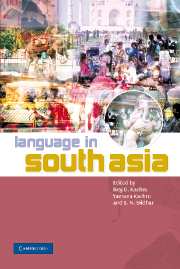Book contents
- Frontmatter
- Contents
- List of Figures
- List of Maps
- List of Tables
- Preface
- Acknowledgments
- List of Abbreviations
- Note on Transcription
- Introduction: languages, contexts, and constructs
- Part 1 Language history, families, and typology
- Part 2 Languages and their functions
- Part 3 Sanskrit and traditions of language study
- Part 4 Multilingualism, contact, and convergence
- Part 5 Orality, literacy, and writing systems
- Part 6 Language conflicts
- Part 7 Language and modernization
- Part 8 Language and discourse
- Part 9 Language and identity
- Part 10 Languages in diaspora
- 25 South Asian languages in the second diaspora
- 26 South Asian diaspora in Europe and the United States
- References
- Subject Index
- Language Index
- Author Index
25 - South Asian languages in the second diaspora
Published online by Cambridge University Press: 04 May 2010
- Frontmatter
- Contents
- List of Figures
- List of Maps
- List of Tables
- Preface
- Acknowledgments
- List of Abbreviations
- Note on Transcription
- Introduction: languages, contexts, and constructs
- Part 1 Language history, families, and typology
- Part 2 Languages and their functions
- Part 3 Sanskrit and traditions of language study
- Part 4 Multilingualism, contact, and convergence
- Part 5 Orality, literacy, and writing systems
- Part 6 Language conflicts
- Part 7 Language and modernization
- Part 8 Language and discourse
- Part 9 Language and identity
- Part 10 Languages in diaspora
- 25 South Asian languages in the second diaspora
- 26 South Asian diaspora in Europe and the United States
- References
- Subject Index
- Language Index
- Author Index
Summary
Introduction
In a survey of South Asian diaspora, it is convenient to identify three focal periods and types of emigration, which I label the first, second, and third diasporas.
The first diaspora, about which little is known, and even less of the languages involved saw Indians traveling to places in Asia, Africa, and Europe. These movements were voluntary and can be further divided into three very different types of movement. One movement was mercantilistic, resulting in settlements in places such as Sri Lanka, parts of South East Asia (Burma, Sumatra, Java, Malaysia, Cambodia), and on the coasts of Arabia, Persia, China, and Africa. Gregory (1971: 10) puts it thus: the fifth, sixth, and seventh centuries have been called the period of Hindu Imperialism, and the reign of Pulakeshi II of the Deccan in the early seventh century, when the imperial fleet consisted of “hundreds of ships,” has been described as “the golden age of India's maritime activity.”
Another movement involved more peaceful activities like the religious impulse which saw the spread of the teachings of the Buddha in Asia some five hundred years after his death (in c. 483 bce). The languages of the first diaspora would have been south Indian languages and forms of Sanskrit and Prakrit. These languages did not survive long, though as expected many loanwords pertaining to culture and religion have spread in this way (e.g. forms like dewa “God” and nirwana “nirvana” in Malay).
- Type
- Chapter
- Information
- Language in South Asia , pp. 497 - 514Publisher: Cambridge University PressPrint publication year: 2008
- 5
- Cited by



